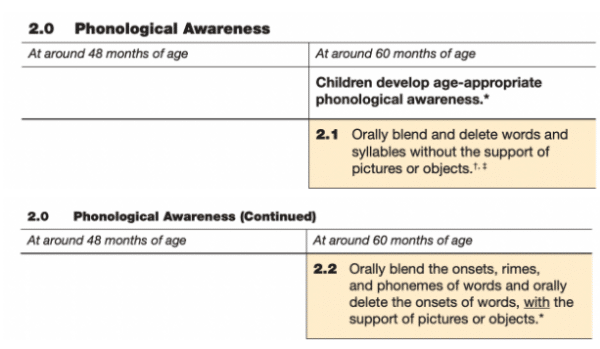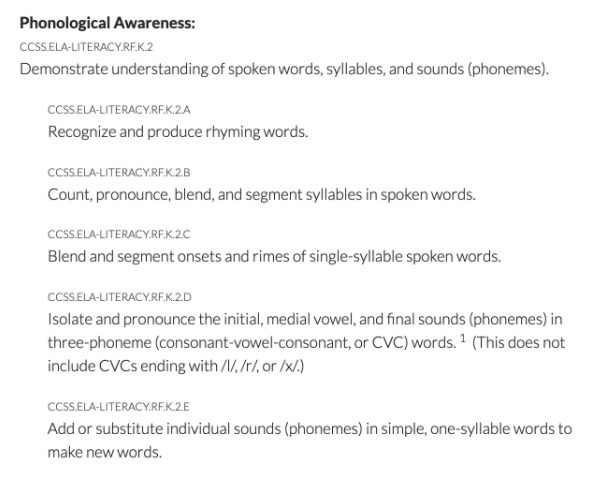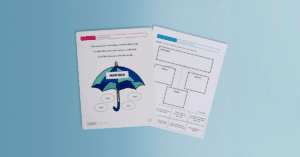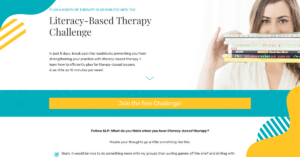This is a guest blog post by Monica, a school-based spech-language pathologist, all about Phonological Awareness Activitiesin school-aged speech therapy!
What is Phonological Awareness?
Phonological awareness is “the ability to identify, process, and manipulate phonological units that compose spoken words of different complexity and size” (Milankov, Golubović, Krstić, & Golubović, 2021).
In other words, phonological awareness is the ability to break down and manipulate spoken words into different parts.
Phonological awareness includes the awareness of words, sentences, syllables, onsets (first sound in a word), rimes (sounds that follow the first sound in a word), and individual sounds in syllables and words (Harbers, 2003).
Some examples of phonological awareness are:
Rhyming: identifying words that rhyme
Counting syllables: identifying how many syllables are in a word
Alliteration: identifying words that begin with the same sound
Phonological Awareness and Phonemic Awareness: What’s the difference?
Before working on phonological awareness and phonemic awareness in your speech therapy sessions, it is important to note the difference between phonological awareness and phonemic awareness.
Picture phonological awareness as an umbrella, with phonemic awareness falling underneath of it. Phonological awareness is the ability to break down and manipulate spoken words and sentences into different parts using larger chunks (think rhyming and counting syllables), whereas phonemic awareness is the ability to manipulate smaller pieces, such as individual phonemes in spoken syllables and words (Harbers, 2003).
Some examples of phonemic awareness are:
Segmenting phonemes: “map” = /m/ + /a/ + /p/”
Substituting phonemes: “say map, what is the word if we switch /m/ with /t/?”
Isolating phonemes: “What is the first sound in map?”
Why is Phonological Awareness important?
Making the jump from research to practice can sometimes feel overwhelming. Working on phonological awareness with students who are already at risk of developing dyslexia is one that translates pretty painlessly. This post will quickly cover why we should target phonological awareness in our sessions and then discuss speech therapy ideas. The activities will focus on preschool to 1st grade, but you could easily adapt them for any age group.
If you follow Dr. Farquarson on Instagram, you know that including phonological awareness activities during speech sound sessions is a must!
The article, Exploring the Overlap Between Dyslexia and Speech Sound Production Deficits, by Cabbage et al. (2018) is a must-read on the connection between dyslexia and speech sound disorders. The article states that, “Approximately 18% of preschool-age children with isolated speech sound disorder (absent of a co-occurring language impairment) have reading difficulty in mid-elementary school” (Cabbage et al., 2018) (Lewis, Freebairn, & Taylor, 2000). “In a separate line of work, an estimated 25% of school-age children with a family history of dyslexia have a history of speech sound disorder in early childhood (Pennington & Lefly, 2001). Thus, speech sound disorder and dyslexia are highly comorbid.”
Long story short, students with speech sound disorders are at a higher risk for developing dyslexia later in life, so including phonological awareness activities is an easy way to introduce reading skills early on (Tambyraja, Farquharson & Justice 2020).
If you want to know more about phonological awareness, check out the podcast episode on Where to Start With Phonological Awareness.
What is the Phonological Awareness Hierarchy?
Now that we have a better idea of what phonological awareness is, let’s take a look at the phonological awareness skills based on complexity. According to Moats & Tolman (n.d.), the following is a list of phonological awareness skills, ranging from the most basic phonological awareness skills to the most advanced phonological awareness skills:
Word awareness: tracking words in sentences
Rhyme and alliteration during word play: enjoying and reciting rhymes and alliterations (not producing)
Syllable awareness: counting, tapping, blending, or segmenting words into syllables
Onset and rime manipulation: producing rhyming words
Phoneme awareness: identifying and matching the sound in words (e.g. “which picture begins with /p/?”, segmenting and producing sounds (e.g. what sound does map start with?”), blending sounds (e.g. /m/ /a/ /p/ = map), segmenting phonemes in words (e.g. map = /m/ /a/ /p/”, and manipulating phonemes by removing, adding or substituting sounds (e.g. “say stop without the /s/”).
Teaching Phonological Awareness Skills using the General Education Curriculum
I typically incorporate phonological awareness into my sessions based on the Preschool Learning Foundations (PLF) and Common Core Standards (CCS).
Here’s a quick snapshot of the PLF and CCS if you need them as a reference:
Preschool Learning Foundations:

Common Core Standards for Phonological Awareness (Kindergarten and 1st Grade)

How to Write Speech Therapy Goals for Phonological Awareness Skills & Phonological Awareness Goal Bank
Like any speech language goals we write, we want to make sure our phonological awareness goals are SMART, meaning our goals are Specific, Measurable, Attainable, Realistic, and Timely.
A great place to start to get ideas for phonological awareness goals is the SLP Now Goal Bank. There are several examples of phonological awareness goals to get inspiration from. Remember, it is important to make goals individualized yo your students!
5 Examples of Speech Therapy Goal Targets For Phonological Awareness Skills:
Listen to a word and identify the first/middle/last phoneme.
Listen to individual sounds and blend them to form a word.
Produce the individual sounds in a stimulus word (e.g. /k/ + /a/ + /t/ for”cat”).
Delete phonemes in a word to form a new word.
Phonological Awareness Skill Building Activities
Now on to the phonological awareness activities! I’m going to cover my favorite ones and how to use them during speech sessions. I weave phonological awareness into my speech therapy activities. They aren’t separate tasks that take a lot of planning or prep. It’s part of the teaching process and works well with auditory discrimination.
Manipulating Individual Syllables
I use small dry-erase boards the most for this activity since it would be a lot of prep work to print and cut out words by syllables for all of my students. They also get practice writing out the words when we use dry erase boards, which teachers love anyways! I try to get a list of sight words from teachers and pick out words that have my student’s sounds.
Write out a target word on the students’ dry erase boards at the top to leave room for them to copy it on the bottom. Draw lines between the syllables and erase syllables, so students practice manipulating words.
Here’s what it might look like if you had a student working on multisyllabic words:
SLP: I’m going to write strawberry on the top. Let’s clap that out and see how many syllables it has. Straw/ber/ry. Did you hear 3? Let’s do it again. Straw/ber/ry. Let’s draw lines between the syllables, and then I’ll have you copy it down at the bottom. We heard 3 syllables, right? So every time you say the word, it should have 3 syllables. Let’s try!
*A prompt to build self-awareness could be, “did that have 3 syllables?”. Students would be able to say yes or no and then try their words again.
SLP: If I take out the first syllable “straw,” what’s left? Ber-ry. If I take out “berry,” what’s left? Straw. If a student can’t get this, I’ll use the dry erase board and cover the syllables to match what I’m saying. Let’s make sure we get all of the syllables when we say our words.
Rhyming Words
Using minimal pairs is an easy way to work on rhyming! I usually use a small set of words (no more than 5) and ask my students if the ending sounds the same. I mix in random words that sound really silly to make it fun when we’re contrasting sounds that don’t rhyme.
Here’s what it might sound like in a session if you were working on fronting:
SLP: Let’s look at these pictures. This person is tall (gesture for tall), and this person is making a call (gesture making a call). Let’s say those words. Tall. Call. Did you hear how both of the words have “all” at the end? Let’s just say “all”. Now let’s add our /t/ sound. Tall. Let’s say “all” again. Let’s add our “c” sound. Sometimes our “c” sound is just like our /k/ sound. Call. Did you hear how they both have the same sound at the end? That means they rhyme. What if I say call/oink. Did those two rhyme? No! That has a different sound at the end.
Other Phonological Awareness Ideas
Go through the minimal pairs and ask students to jump or do some movement or gesture every time the pairs rhyme, then sit down if they don’t.
Have the words separated into onset and rime. Have your students say what you hold up so that they have a visual of the rime being the same. Write the “c” and /t/ on their own and then have /all/ on its own and then put them all together to make words and also say /all/ by itself to build awareness. This is also a great way to work on blending.
Add some fun to repetitions by varying the speed of combining and deleting the onset and rime as they repeat them. Verbal instructions for this one could be, “Let’s put this one together fast” or “Let’s put this one together super slow”.
You could also put the pictures down and have students pick up matching rhyming pairs. You could modify this to add movement by sticking your pairs on the wall with some sticky tack and standing for parts of your session. You could make a scavenger hunt for the rhyming word after you’ve gone over all of the pairs. The ideas are endless!
Isolating Sounds
I use isolating sounds the most out of all of the phonological awareness tasks. It also really helps my deaf and hard of hearing (D/HH) students. If you have any students with initial or final consonant deletion, you’re probably already including it in your sessions. I love that it’s auditory discrimination and phonological awareness all rolled into one.
I mainly use gestures as we talk about our sounds and go through repetitions.
If a student is working on /s/ blends, I will ask them if the /s/ sound is in the front of the back. I put my hand on my heart for the “front” sound and point to my back for the “back” sound.
SLP: Our word is “spot”. Did you hear the /s/ sound in the front (hand to your heart) or in the back (point to your back)? Spot. I heard that in the front (hand to your heart). I want you to try the next word. Spill. Did you hear the /s/ sound in the front or the back? Yes! The front. What’s our back sound? Spill. It’s an /l/ sound! I will say the sound for new words and ask, “What sound did you hear in the front?” and “What sound did you hear in the back?”.
When a Student Responds Incorrectly
I ask, “Where is the /s/ sound? Front or back?”
Then I say, “You’re right! It’s in the front, try your word again.”
After enough times, if I ask “front or back,” they can correct their sound by themselves.
It works really well with initial /s/ blends and leads to less prompting pretty fast. I love that it builds self-awareness and self-correction quickly too.
Deleting and Manipulating Sounds
Here’s another activity that’s perfect for working on blends. Let’s say a student was working on /l/ blends. I use a dry erase board, or we make it a listening/auditory discrimination activity.
SLP: We’re going to work on the word “flip”. What’s the first sound we hear in “flip”? That’s right, an /f/ sound. What happens if I take the /f/ sound off? It becomes “lip”! Let’s try with some more words.
It also works well with final and initial consonant deletion.
SLP: Let’s work on the word “cat”. I’m going to write it out. If I cover up the “c” what do we have? At! Let’s try to say all the sounds by themselves “C-A-T”. If we put those all together, what does it make?
I often mix and match phonological awareness activities and put a couple of them together depending on what process we’re working on. I also adjust based on how much support my students need. Tambyraja, Farquharson & Justice (2020) highlight the unique skill and importance SLPs have in developing early reading skills with our students during speech therapy sessions. I love that I’m helping my students work on their reading skills, and it doesn’t take a lot of effort on my part.
I also love this resource from Reading Rockets. They partnered with the National Education Association and Colorín Colorado to make a guide for parents. It’s great for educators too. They have lots of activities for phonological awareness. It’s a great place to look if you want more ideas.
References
Cabbage, K. L., Farquharson, K., Iuzzini, -Seigel Jenya, Zuk, J., & Hogan, T. P. (2018). Exploring the Overlap Between Dyslexia and Speech Sound Production Deficits. Language, Speech, and Hearing Services in Schools, 49(4), 774–786.
Harbers, Heidi. (2003). Phonological Awareness and Treatment Outcomes. Perspectives on Language Learning and Education 10, 21-26.
Lewis, B. A., Freebairn, L. A., & Taylor, H. G. (2000). Academic outcomes in children with histories of speech sound disorders. Journal of Communication Disorders, 33(1), 11–30.
Pennington, B. F., & Lefly, D. L. (2001). Early Reading Development in Children at Family Risk for Dyslexia. Child Development, 72(3), 816–833.
Milankov, V., Golubović, S., Krstić, T., & Golubović, Š. (2021). Phonological Awareness as the Foundation of Reading Acquisition in Students Reading in Transparent Orthography. International journal of environmental research and public health, 18(10), 5440.
Moats, L, & Tolman, C (n.d.). The development of phonological skills. Reading Rockets. https://www.readingrockets.org/topics/developmental-milestones/articles/development-phonological-skills
Tambyraja, S. R., Farquharson, K., & Justice, L. (2020). Reading Risk in Children With Speech Sound Disorder: Prevalence, Persistence, and Predictors. Journal of Speech, Language, and Hearing Research, 63(11), 3714–3726.




Reader Interactions